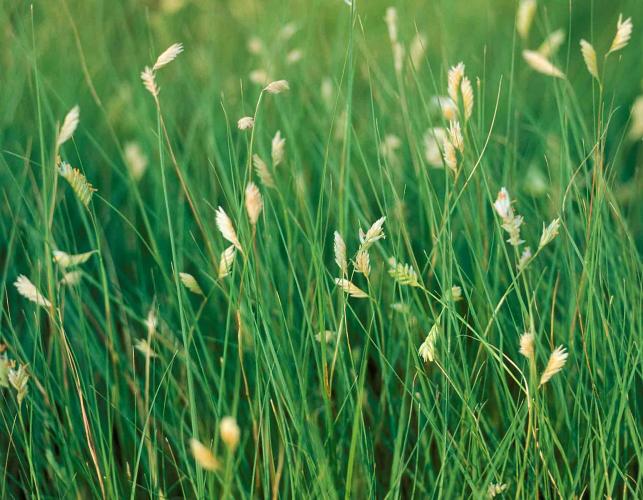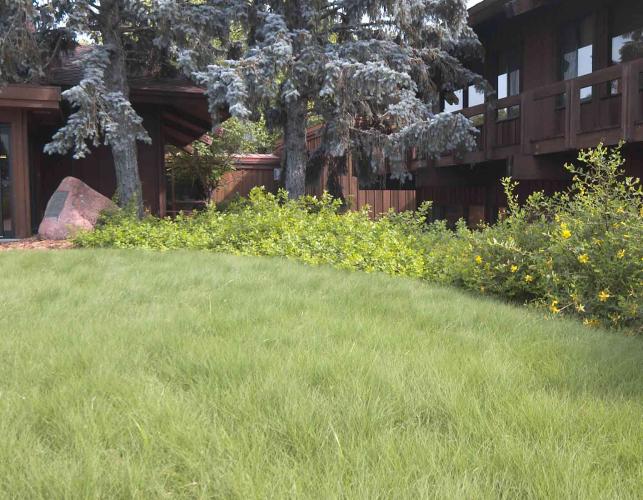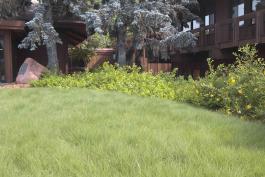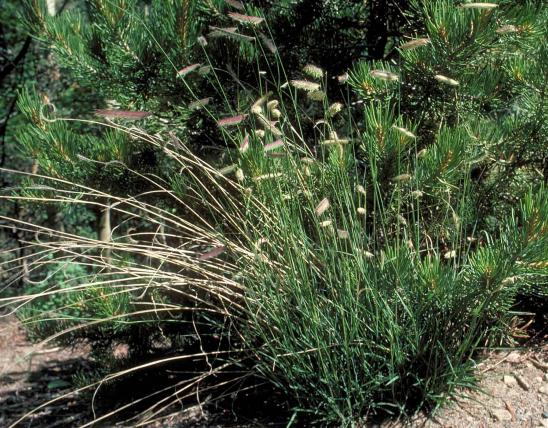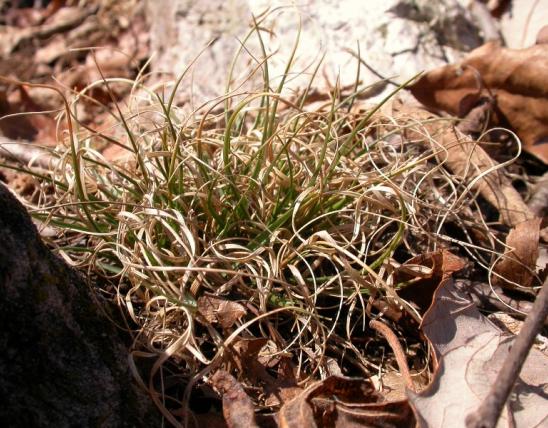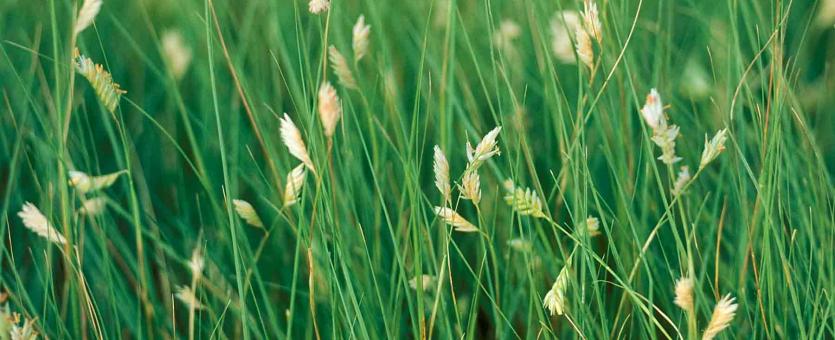
Buffalo grass is a native perennial warm-season short grass that creeps widely by stolons (runners), which take root at the joint. It forms dense mats. It is dioecious (staminate and pistillate flowers are produced on separate male and female plants).
Leaf blades are ½–4 inches long, less than ⅛ inch wide, and flat but curling. There is a line or band of hairs where the leaf blade bends away from the leaf sheath.
The flowering stems are held erect. The flowering stems of male plants are taller than those of the female. The male (staminate) flowering stalks have 1–4 spikes (separate flower clusters) branching away from the central stem on short stalks, held well above the leaves. Each spike contains 6–12 spikelets that are positioned along one side of the spike stalk, looking rather flattened, something like a tiny comb. The anthers are reddish orange. The flowering stems of female (pistillate) plants have the spikelets enclosed in usually 2 hard, burlike clusters that are partially hidden among the leaves, each with 2–5 spikelets. Upon maturity, the burlike clusters are shed intact as a unit. Flowers May–August.
Note that where buffalo grass is planted as a lawn, male flowers may not be present, or may be rare, since cultivated forms usually include only the female plants.
Similar species: Buffalo grass looks like a short version of grama grasses (Bouteloua spp.), such as blue grama and hairy grama. Note however, that buffalo grass spreads by runners, while grama grasses are clump-forming; also, that buffalo grass is dioecious, with separate male and female flowers on separate male and female plants, while the grama grasses are monecious, with both pistils and stamens functioning on a single flower.
Height: flowering stems 4–8 inches (male plants); 1–2 inches (female plants).
As a native, rare in the glaciated plains of far northwestern Missouri; introduced sporadically elsewhere in the state.
Habitat and Conservation
As a native, buffalo grass occurs in Missouri’s loess hill prairies in our far northwestern counties. It has been introduced sporadically elsewhere, however, so it also occurs on roadsides, railroads, and other open, disturbed areas. It is gaining in popularity as a lawn grass.
In the western, drier portions of the Great Plains, buffalo grass is a major component of the shortgrass prairie, where it occurs with blue grama. The native distribution of both these species in Missouri is in the far northwestern corner.
The regional distribution of short, mid, and tallgrass prairies has a great deal to do with the amount of precipitation the region receives. Shortgrass prairie occurs in dry areas in the high western plains (in the United States, Montana southward through eastern Wyoming, Colorado, and New Mexico and the Texas panhandle). Meanwhile, tallgrass prairie is the on the eastern part of the Great Plains; it is the native grassland of Missouri, Iowa, Minnesota, and Illinois. Tallgrass prairie receives more moisture and is at generally lower elevations. Midgrass prairie is positioned as a strip, from North Dakota southward, well into Texas, in between tallgrass and shortgrass regions.
Status
As species of conservation concern in Missouri, it is ranked SH: historic, or possibly extirpated from within our borders. It is known only from historical records, but there is still hope that it might be rediscovered growing naturally in our state.
Native perennial warm-season short grass, creeping widely by stolons and forming dense mats.
Buffalo grass is the only species in its genus.
Human Connections
Buffalo grass is an important and widespread range grass in the Great Plains, where it is considered an excellent native forage species for livestock.
Buffalo grass has been gaining popularity as a native lawn grass in full sun for golf courses, highway rest areas, and commercial and residential plantings. It is drought resistant and, because of its low stature, requires little mowing. Many or the cultivars currently sold as seeds, plugs, or sod are “male-sterile” lines, in which no staminate (male) plants are produced, because pistillate (female) plants have shorter flowering stems than do staminate ones.
People have developed specialized cultivars especially for forage or turfgrass uses.
Ecosystem Connections
With its thick sod of roots and runners, buffalo grass helps prevent erosion in the dry landscapes where it is common.
Buffalo grass got its name because in presettlement times on the Great Plains, the once-vast herds of American bison regularly grazed this species. Deer and pronghorn antelope graze on it, too.
A variety of grasshoppers chew the leaves of this grass, and other insects suck its sap. As with other grasses, its presence, along with other grassland plants, is the anchor for the entire grassland ecosystem, and all the animals that rely on that habitat.
Warm-season grasses like buffalo grass perform photosynthesis most efficiently during the hottest time of year, meaning that while other grasses go dormant in the dog days of summer, they become lush and green. On the flip side, they are slower to turn green in spring than cool-season grasses. If you look at the various grasses in people’s lawns, you’ll probably see nonnative zoysia or Bermuda grass doing the same thing, remaining yellowish or straw-colored from mid-fall all the way into late spring. Many of our spectacular native prairie grasses are warm-season species, and one clue to finding a prairie is to take note of deep green grasslands in the hottest, driest part of summer.
